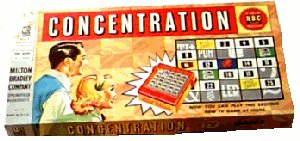
The photograph at the left is a copy of the 1958 version of the Milton Bradley game. It was donated to the collection in 1991. The cardboard box is 24.5cm by 48cm by 4.5cm deep. Whitehill indicates that the Milton Bradley boxed game of Concentration is based upon a popular television program of the same name that began in 1958. However, he points out that the origin of the game has been traced to an early 1930's playing card game called Pick A Pair, reported in the U.S. in Childlife magazine.
According to Alfonzo Smith (a collector colleague of Whitehill) the original "...object of the game of Concentration is to solve a rebus puzzle that is revealed piece by piece as players match pairs."

The photograph on the right shows the game parts for Concentration. As on the television game show, there is a "Rolomatic" cube in which to insert cardboard cards with puzzles to solve, and play money to award as prizes. The money is in denominations of 50, 100, and 500.
A little more "digging" reveals that the original game is also known as Pelmanism in England. This is an earlier version of the game of Pick a Pair, and it is described by L.H. Dawson, in a note to a British edition of Hoyle's Games Modernized (London: George Routledge & Sons, Ltd., page 230, no date but as suggested in the Preface, c1930). Dawson writes:
Pelmanism is a very simple game indeed, and, as its name implies, is a splendid exercise for the for the memory... We may add that the Pelman Institute for the Scientific Development of Mind Memory is in no way responsible for the game, and that, to the best of our belief, the rules have never before appeared in print.
In Pelmanism, the standard deck of playing cards is placed in rows face down. (An alternative is to place the cards in concentric circles.) The game may be played by two or more players. The first player turns two cards face up. If they are a pair, they are kept, and that player goes again. If not, the cards are returned to the same place face down, and the next player repeats the same actions. However, if the first card the second player draws matches one of the previous cards turned over, then a pair can be secured, the pair is kept, and that player goes again. The game is continued in a similar manner until all of the cards have been won. The winner is the one with the most pairs. A similar game, a version of Solitaire called Extrasensory Perception, is explained in D. Brown, 150 Solitaire Games, New York: Harper and Row, 1966, page 128. Brown reports that the game is based on ESP tests made at Duke University in North Carolina. A special 25 card deck with symbols was used at Duke, but a regular playing card deck could be used to play the game.

In 1998, Sierra issued a CD titled Hoyle Card Games that were to play on an IBM PC. One of these games is pictured in the screen capture at the left. This is the game of Memory Match, and appears to be a combination of Pelmanism and Extrasensory Perception.
The Sierra game can be set-up with a number of different sized layouts, levels of play, and opponents. It can also be played across the Internet with opponents. In addition to help files, an accompanying book explains the game and offers strategies for winning the game.
In 1979, the Museum purchased it's first desktop computer. This was before the era of an IBM PC. The computer was a Z80 Compucolor and it was delivered with a number of games on floppy 8 inch cardboard discs. One of these games was Concentration. Unfortunately, we no longer have a way to obtain a photograph of the game that was generated on the screen. The software for the game was written in an early form of BASIC, and the graphics drawn were inherent to the Z80 processor. A computer user played against the computer. The screen display illustrated a matrix of player selected size. The cells included "numbers" rather than symbols. Play was via the keyboard. As the game progressed, the screen display changed. A player's score appeared in white below the matrix. A table of random numbers were used by the software in the play of the game. This was before desktop computers had sound or a mouse.
Last update March 5, 2010